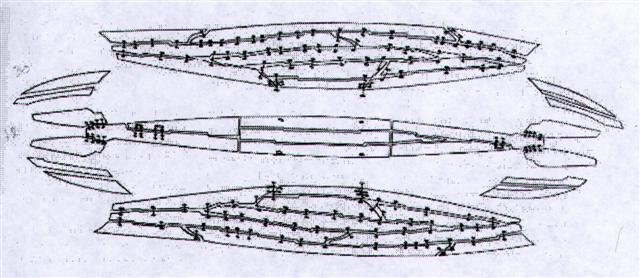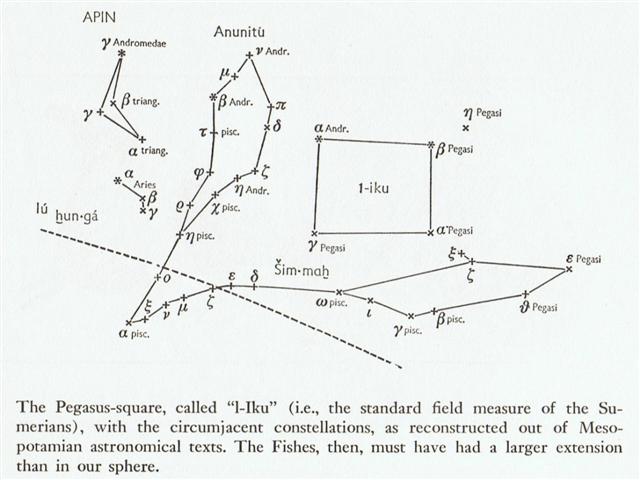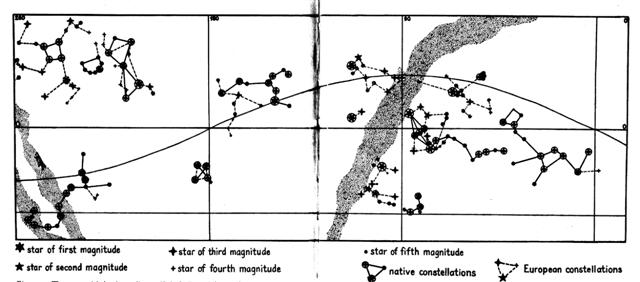This is the ship of Pharaoh. Its planks are sewn together and each plank was uniquely designed to fit together with the whole. (Source: Shirley Wachsmann, Seagoing Ships & Seamanship in the Bronze Age Levant.) Number was obviously essential:
... The four bereaved and searching divinities, the two mothers and their two sons, were joined by a fifth, the moon-god Thoth (who appears sometimes in the form of an ibis-headed scribe, at other times in the form of a baboon), and together they found all of Osiris save his genital member, which had been swallowed by a fish. They tightly swathed the broken body in linen bandages, and when they performed over it the rites that thereafter were to be continued in Egypt in the ceremonial burial of kings, Isis fanned the corpse with her wings and Osiris revived, to become the ruler of the dead. He now sits majestically in the underworld, in the Hall of the Two Truths, assisted by forty-two assessors, one from each of the principal districts of Egypt; and there he judges the souls of the dead. These confess before him, and when their hearts have been weighed in a balance against a feather, receive, according to their lives, the reward of virtue and the punishment of sin.
When the 'old ship' had reached his end a new one ought to be constructed - a new 'house' for the gods to live in: ... In the morning of the world, there was nothing but water. The Loon was calling, and the old man who at that time bore the Raven's name, Nangkilstlas, asked her why. 'The gods are homeless', the Loon replied. 'I'll see to it', said the old man, without moving from the fire in his house on the floor of the sea. Then as the old man continued to lie by his fire, the Raven flew over the sea. The clouds broke. He flew upward, drove his beak into the sky and scrambled over the rim to the upper world. There he discovered a town, and in one of the houses a woman had just given birth. The ship of Noah had the form of a perfect cube, we learn from the Babylonian version: ... Utnapishtim is spry enough to tell [Gilgamesh] in great detail the story of the Deluge. He tells how Enki-Ea has warned him of Enlil's decision to wipe out mankind, and instructed him to build the Ark, without telling others of the impending danger. 'Thus shalt thou say to them: (I will ... go) down to the apsu and dwell with Ea, my (lor)d.' He describes with great care the building and caulking of the ship, six decks, one iku (acre) the floor space, as much for each side, so that it was a perfect cube [a sign of Saturn], exactly as Ea had ordered him to do. This measure '1-iku' is the name of the Pegasus-square, and the name of the temple of Marduk [the spring sun god] in Babylon, as is known from the New Year's Ritual at Babylon, where it is said: 'Iku-star, Esagil, image of heaven and earth.' When Castor (who was ruling 'the Heart', the half of the year with watery ways) gave way for his immortal twin Pollux (who was ruling 'the Feather', the high sky half of the year) the constructional parts of the old stranded 'Ship' could be reused for building a 'House': ... After the food supplies had been brought on land, the two rulers, the king and the queen said, 'Drag the canoes on land and take them apart (so the wood can be used) to build houses and cover the roofs!' They dragged the two canoes on land and took them apart. Instead of the Egyptian 12 months (planks) the ideal 'house-ship' on Easter Island could have had 10 planks (months). There were 10 days from ihe tau in Ga2-20 (50) to the heliacal rising of Al Tarf ('the End', β Cancri) - when Ras Algethi (α Herculis) culminated at midnight:
10 'kings' (ariki motogi) were enumerated at the beginning of Manuscript E, beginning with Ko Oto Uta and ending with Ko Hotu.a Matua:
... A Sumerian tablet, now in Oxford (Weld-Blundell, 623), gives a list of ten mythological kings who ruled for a total of 456,000 years in the period between the first descent of kingship from the courts of heaven upon the cities of men and the coming of the Flood. A second tablet (Weld-Blundell, 144) names only eight of these kings, with a total of 241,200 years; and a third list, very much later, composed in Greece c. 280 B.C. by the learned Babylonian priest Berossos ... gives all ten kings again, but with a total of 432,000 years - which is an extremely interesting sum. For in the Icelandic Poetic Edda it is told that in Odin's heavenly warrior hall there were 540 doors: Five hundred doors and forty there are, // I ween, in Valhall's walls; // Eight hundred fighters through each door fare // When to war with the Wolf they go. The 'war with the Wolf' in that mythology was the recurrent cosmic battle of the gods and the antigods at the end of each cosmic round (the Götterdämmerung of Wagner's Ring), and as the reader - ever alert - has no doubt already realized, 540 times 800 is 432,000, which is the number given by Berossos for the sum of years of the antediluvian kings. Furthermore, in the Indian Mahabharata, and other texts of the Puranic period (c. 400 A.D. and thereafter), the cosmic cycle of four world ages numbers 12,000 'divine years' of 360 'human years' each, which is 4,320,000 human years; and our particular portion of the cycle, the last and worst, the so-called Kali Yuga, is exactly one-tenth of that sum. So that we have found this number, now, in Europe, c. 1100 A.D., in India, c. 400 A.D., and in Mesopotamia c 300 B.C., with reference in each case to the measure of a cosmic eon. (Campbell The Masks of God: Oriental Mythology.) By analogy with the ancient king lists we can guess that in Manuscript E ariki motogi ko oto uta corresponded to Adam and ariki motogi ko hotu.a matua to Noah:
I.e. perhaps king Hotu A Matua could be considered as ruling up to the time of the Flood, there to embark on a ship, which after a long voayge ultimately would take him to the beginning of his next cycle - there to make landfall and change his name to king Oto Uta as its first ruler. Not much different from the old man at the bottom of the sea 'who at that time bore the Raven's name'. The Pegasus Square could be the place where the Ark stranded.
432 = 2 * 216 = 2 * (200 + 16) = 32 + 2 * 20². With a pair of 'halfyears' for a cycle there should be another square at the opposite side of the sky, and indeed there is, viz. at Raven (Corvus):
|
||||||||||||||||||||||||||||||||||||||||||||||||||||||||||||||||||||||||||||||||||||||||||||||||||||||||||||||||||||||||||||||||||||||||||||||||||||||||||||||||||||||||||||||||||||||||||||||||||||||||||||||||||||||||||||||||||||||||||||||||||||||||||||||||||||||||||||||||||||||||||||||||||||||||||||||||||||||||||||||||||||||||||||||||||||









